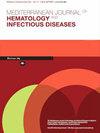PLASMABLASTIC LYMPHOMA. A STATE-OF-THE-ART REVIEW (1)
IF 2
4区 医学
Q3 HEMATOLOGY
Mediterranean Journal of Hematology and Infectious Diseases
Pub Date : 2024-01-01
DOI:10.4084/mjhid.2024.007
引用次数: 0
Abstract
The objective of this two-part study is to present current and comprehensive understanding on the diagnosis and management of plasmablastic lymphoma. The first section, as presented in this paper, is on the study of epidemiology, etiology, clinopathological characteristics, differential diagnosis, prognostic variables, and the impact of plasmablastic lymphoma on specific populations. Plasmablastic lymphoma (PBL), a rare and aggressive form of lymphoma. Previous and modern studies have demonstrated a significant association between the human immunodeficiency virus (HIV) and the development of the disease. The limited occurrence of PBL contributes to a lack of comprehensive understanding regarding the molecular mechanisms involved in its etiology. Consequently, the diagnostic procedure for PBL poses a significant difficulty. Among the group of CD20-negative large B-cell lymphomas, PBL can be correctly diagnosed by identifying its exact clinical characteristics, anatomical location, and morphological characteristics. PBL cells do not express CD20 or PAX5 but possess plasmacytic differentiation markers such as CD38, CD138, MUM1/IRF4, Blimp1, and XBP1. PBL must be distinguished from other B-cell malignancies that lack the CD20 marker, including primary effusion lymphoma, anaplastic lymphoma kinase-positive large B-cell lymphoma, and large B-cell lymphoma (LBCL). This condition is frequently associated with infections caused by the Epstein-Barr virus and genetic alterations involving the MYC gene. Despite advances in our comprehension of this disease, the prognosis remains dismal, resulting in a low overall survival rate, although recent reports suggest an apparent tendency towards substantial improvement.浆细胞性淋巴瘤。最新综述 (1)
本研究由两部分组成,旨在介绍目前对浆细胞性淋巴瘤诊断和管理的全面认识。本文的第一部分主要研究浆细胞性淋巴瘤的流行病学、病因学、临床病理学特征、鉴别诊断、预后变量以及对特定人群的影响。 浆细胞性淋巴瘤(PBL)是一种罕见的侵袭性淋巴瘤。以往和现代的研究都表明,人类免疫缺陷病毒(HIV)与该病的发生有显著关联。由于 PBL 的发病率有限,因此对其病因的分子机制缺乏全面的了解。因此,PBL 的诊断程序存在很大困难。在 CD20 阴性大 B 细胞淋巴瘤中,PBL 可通过确定其确切的临床特征、解剖位置和形态学特征来正确诊断。PBL 细胞不表达 CD20 或 PAX5,但具有浆细胞分化标记,如 CD38、CD138、MUM1/IRF4、Blimp1 和 XBP1。PBL 必须与其他缺乏 CD20 标记的 B 细胞恶性肿瘤区分开来,包括原发性渗出淋巴瘤、无性淋巴瘤激酶阳性大 B 细胞淋巴瘤和大 B 细胞淋巴瘤(LBCL)。这种疾病通常与 Epstein-Barr 病毒感染和涉及 MYC 基因的遗传改变有关。尽管我们对这种疾病的认识有所进步,但其预后仍然不容乐观,总体存活率很低,不过最近的报告显示,这种疾病有明显好转的趋势。
本文章由计算机程序翻译,如有差异,请以英文原文为准。
求助全文
约1分钟内获得全文
求助全文
来源期刊

Mediterranean Journal of Hematology and Infectious Diseases
Medicine-Hematology
CiteScore
4.20
自引率
6.20%
发文量
113
审稿时长
12 weeks
期刊介绍:
Reciprocal interdependence between infectious and hematologic diseases (malignant and non-malignant) is well known. This relationship is particularly evident in Mediterranean countries. Parasitosis as Malaria, Leishmaniosis, B Hookworms, Teniasis, very common in the southeast Mediterranean area, infect about a billion people and manifest prevalently with anemia so that they are usually diagnosed mostly by experienced hematologist on blood or bone marrow smear. On the other hand, infections are also a significant problem in patients affected by hematological malignancies. The blood is the primary vector of HIV infection, which otherwise manifest with symptoms related to a reduction in T lymphocytes. In turn, infections can favor the insurgency of hematological malignancies. The causative relationship between Epstein-Barr virus infection, Helicobacter pylori, hepatitis C virus, HIV and lymphoproliferative diseases is well known.
 求助内容:
求助内容: 应助结果提醒方式:
应助结果提醒方式:


